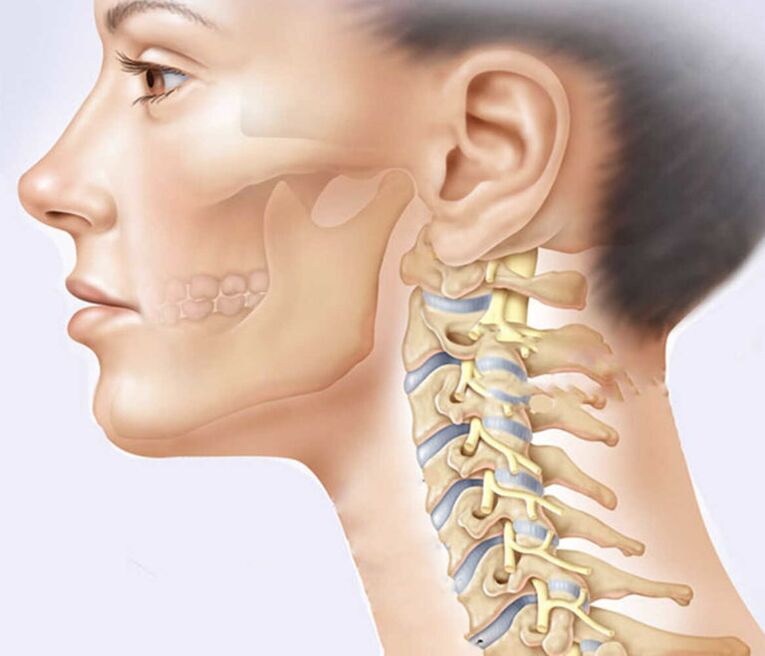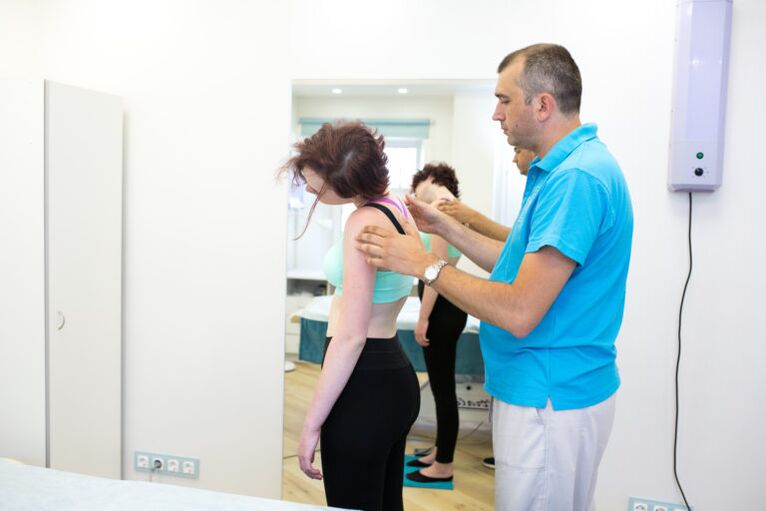They all had severe neck pains. It is not necessary for this to have an accident or anomaly in the structure of the vertebrae. Improper workplace organization, inactive lifestyle, intense physical activity - all this can lead to severe pain. With age, the manifestations of osteochondrosis can be complicated, and diseases of the internal organs only add to the problems.
Sharp pains in the neck can occur suddenly, for example, by a sharp turn or tilt of the head. It can radiate to the head (mostly to the back of the head), chest or even shoulders. Such phenomena are often the result of cervical lumbago (cervicago) or acute muscle spasms. We stopped in a draft, lifted a heavy one - severe neck pains can last for 5-10 days, but then they pass. If the duration of pain lasts more than 10 days, they have a sharp, painful or dragging character, significantly reduce the quality of life - you should seek treatment.

Because many lymph vessels, large veins, and arteries pass through the cervical area, any problems in it must be treated carefully. The musculoskeletal cavity of the neck contains the thyroid gland, pharynx, beginning of the esophagus, larynx, and upper trachea. The neck muscles participate in the movement of the head, shoulders, and even the jaw. Therefore, if you feel neck pain, consult a doctor immediately to find out the causes and prevent a number of serious problems.
Doctors will examine the condition of your spine and brain, take X-rays, CT or MRI, check the degree of tension in the muscles of the neck, shoulders and upper back. Determining the cause of the pain may result in the need for treatment rather than the cervical spine at all. You should also be prepared for exercise that will become a part of your daily life.
Severe pain in the cervical spine is a very important and practically significant problem in neurology. Its importance is determined by the following factors:
- neck pain with osteochondrosis are the most common pathologies caused by non-infection.
- painful sensations in the neck are prone to a chronic course with exacerbations. Frequent intense pain can result in temporary or even permanent disability.
These factors determine the importance of seeking medical help in a timely manner. If you feel any discomfort or pain, see a specialist immediately. Self-treatment in such cases is unacceptable, because it can cause serious complications.
In addition, self-medication often leads to the need for surgery and causes disability in adults.
Only a doctor can competently put together a therapeutic regimen, including pain relief.
Types of neck pain
Distinguish cervical pain (cervicalgia) and cervical lumbago (cervicago). Cervicalgias are:
- superficial somatic - associated with skin damage;
- deep somatic - due to damage to the cervical muscles and vertebrae;
- visceral - scattered, caused by infections or diseases of internal organs.
Cervicalgias affected adjacent areas are divided into two types:
- cervicobrachialgia - cervicobrachial syndrome with pain radiating from the neck to the shoulders;
- cervicocranialgia - feelings of pain begin directly in the cervical or occipital area and spread to the head.
Cervical pain of all types can be acute or chronic. The acute phase lasts about 10 days, but without proper treatment it can become chronic. Chronic pain is thought to last longer than three months.
Cervicago is always an acute feeling of pain localized in the cervical spine and does not allow you to turn your head.
If the problems are caused by neuropathic reasons, they can be central (with damage to the spine) or peripheral (damage to peripheral nerves).
Causes of neck pain
Usually, the causes of neck pain can be divided into two groups - arising from a disease of the spine or due to other factors. The first are formed in the background of intervertebral hernias, arthrosis, joint dysfunction, as well as subluxation of the vertebrae (whiplash). The consequences of these injuries can be felt throughout life. The second group includes neck pain caused by infectious and endocrine disorders, tumor processes, rheumatism.
Some of the most common causes of neck pain include:
- Myofascial syndrome.It occurs against the background of long-term excessive tension of the neck muscles, sprains, hypothermia. They usually cause short-term painful sensations of moderate intensity, in which the mobility of the head is often limited, and the muscles spasm. When pressed, pain and hardening are felt. Often the pain caused by myofascial syndrome disappears on its own within 4-5 days.
- Osteochondrosis of the cervical spine.The disease is a degenerative-dystrophic lesion of the spine that occurs as a result of deformation and destruction of the intervertebral discs. As a result of loss of elasticity, compression and destruction of the discs, the facet joints are overloaded, arthrosis and nerve root tightening occur. This leads to the fact that the whole neck hurts a lot. With age, a decrease in cartilage hydrophilicity leads to a decrease in the distance between the vertebrae and damage to the intervertebral joints.
- Facet joint dysfunction.Damage to the structure of the intervertebral joints is one of the most common reasons why the whole neck hurts. The cartilage becomes thinner on the articular surfaces. This causes the appearance of bone growths - osteophytes. They narrow the lumen of the hole between the vertebrae, causing compression of the nerve endings. This is usually accompanied by dull pain (which gradually intensifies, of low intensity) in the neck area, which intensifies in the morning after sleeping in an uncomfortable position - on a high pillow, lying on your stomach. During movement the pain may increase, but at rest it weakens. In this case, pain radiating to the nape of the neck, ear, temples, shoulders is possible.
- Hernias and protruding discs.As a result of compression of the intervertebral discs, which have lost elasticity, protrusions are formed - protrusions into the spinal canal with the subsequent formation of a hernia. This leads to compression of the spinal cord, which impairs the sensitivity of the hands - numbness, burning sensation, weakness, accompanied by pain. Shooting (irregular one-sided) intensifies when bending, turning the head or throwing backwards. Therefore, the person must instinctively tilt his head forward and to the sides opposite to the localization of pain.
- Cervical myelopathy. . . Prolonged compression of the hernia disrupts blood circulation in the spinal cord. That’s why it doesn’t just hurt your whole neck. But the violation is accompanied by pain that radiates to the area between the shoulder blades and the shoulder. They get worse during movement and do not disappear even after taking painkillers. Characteristic signs of neck pain with cervical myelopathy are geese, numbness of the arms and legs, and fine motor disorders. Sometimes dizziness is possible, memory deteriorates, gait changes.
- Whip injuries.They occur as a result of a sharp bending of the door backwards or forwards, followed by a jerk in the opposite direction. Such injuries often occur during an accident, but even a simple fall on the back can provoke them. Trauma occurs as a result of stretching and damage to muscles, ligaments of intervertebral discs and cervical vertebrae. The most severe cases were followed by sprains and fractures. The consequence of the injury can be that the whole neck and shoulders are very painful, migraines occur, muscles spasm. Concomitant symptoms include blurred vision, increased fatigue, and frequent headache attacks.
In addition, neck pain can cause muscular-tonic syndrome. It is a condition that causes a prolonged cramp of several muscle groups in the head, chest and neck. Compression of neuromuscular triggers leads to withdrawal, sometimes very intense pain. In particular, scapular muscle syndrome is a symptomatic complex, accompanied by a violation of the innervation and blood circulation of the scapular muscles of the neck, which go from the cervical vertebrae to the 1st and 2nd ribs. This syndrome is characterized by cervical pain and stiffness, which most commonly occur in the morning. The head in such cases is usually tilted forward and slightly tense. Painful sensations can be light, painful, but sometimes sharp, intensifying at night, with deep breaths, while tilting the head to the healthy side. It is sometimes possible to radiate pain in the shoulders, in the axillary and interscapular regions, as well as in the front of the chest.

However, the causes of pain are not just spinal diseases. First of all, it is necessary to exclude infectious pathologies, especially nonspecific or tuberculous spondylitis, epidural abscesses. Metastatic lesions of the vertebrae can be accompanied by permanent pain, which does not subside, but worsens at rest. They are characterized by fever, general weakness and sweating. Even mild pressure on spinous processes causes attacks of local pain.
Risk factors that cause pain include flat feet, curvature of posture, and strenuous exercise. Cervical pain can occur in the background of constant overexertion, vibration, prolonged immobility of the body (for example, with fractures).
In addition, pain can occur as a result of wearing tight and uncomfortable clothing, malnutrition, and internal organ disease. Taking these factors into account, we obtain a wide range of clinical cases in which cervicalgia is formed.
Neck hurts: who to turn to and what to do
If your neck hurts, traditional medicine offers treatment with drugs of different spectrum of action. They are designed to fight pain, to alleviate infectious or inflammatory processes and to eliminate unpleasant symptoms. The operation is performed only in very severe cases.
Drug treatment is based on the use of local anesthetics, analgesics (NSAIDs), hormonal drugs (glucocorticoids), muscle relaxants (drugs to relieve muscle tension), antioxidants and, if necessary, antidepressants and anticonvulsants. Treatment is based on pain relievers - drugs from other groups are prescribed as concomitant drugs that enhance the effect of relieving pain, relieve inflammation and swelling.

The disadvantage of drug treatment is the huge number of side effects and temporary pain relief. In addition, such treatment is aimed only at eliminating the symptoms, but in no way focused on the underlying cause of the pain.
Who should be entrusted with such an important department for the body - the neck? In case of severe pain, one specialist is not needed, but an entire team that carefully examines, makes an accurate diagnosis and prescribes therapy.
An integrated approach based on a combination of the following non-drug methods is applied:
- Physiotherapy.The neck muscles are very difficult to train, so when choosing exercises, experts focus on the mobility of the chest, shoulder girdle, as well as the even distribution of the load on the spine. Exercise doctors choose the optimal set of exercises aimed at shaping posture and eliminating neck pain.
- Kinesiotherapy.Clinics use kinesiotherapy systems. The installation allows you to work deeply on the muscles of the cervical spine. With the help of closed chains of exercises, they can effectively manage the neuromuscular problems of the skeleton and increase the functionality of the department.
- Osteopathy.Osteopathic neck correction is safe and painless, it is suitable for adults and children, pregnant women and professional athletes. Unlike other therapeutic methods, osteopathic medicine not only eliminates the pain syndrome, but also relieves the patient of the source of pain and cures the underlying disease. For that, palpation and manual manipulation techniques are used on muscles, joints, nerves, connective tissue, vessels and capillaries of the neck. Methods of osteopathic medicine accelerate recovery, increase the effectiveness of therapeutic, prophylactic or rehabilitation measures.
- Manual therapy.Effectively relieves tension from the neck. Specialists gently affect the biologically active points, remove subluxations, displacements, perform manipulations aimed at relaxing the neck muscles, stretching the spine.
Competent selection and the right combination of therapeutic methods help to eliminate neck pain and resolve discomfort. The integrated approach includes the joint well-coordinated work of different specialists - rehabilitologists, neurologists, traumatologists, orthopedists, psychologists. They all follow the common goal of pain relief for the patient. An individual approach to everyone is important, a combination of osteopathic and physiotherapeutic procedures, and even working on the deep, mental reasons for the fact that the whole neck hurts a lot.

















































